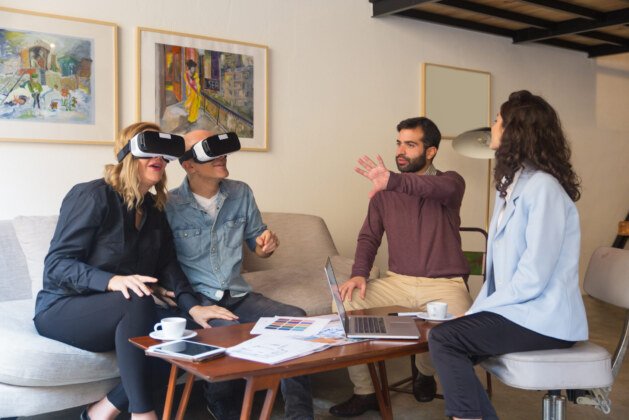In the dynamic landscape of the real estate industry, staying ahead of the competition requires innovative approaches to property marketing. One such groundbreaking tool that has reshaped the way properties are showcased is the 360° virtual tour. As technological advancements continue to revolutionize various sectors, real estate professionals are increasingly turning to immersive experiences to attract buyers and tenants. In this blog post, we will explore how 360° virtual tours can transform your real estate business and elevate your property marketing strategies.
The Evolution of Property Marketing
Traditionally, property marketing relied heavily on static images, floor plans, and written descriptions. While these methods have been effective to some extent, they often fall short in providing potential buyers or tenants with a comprehensive understanding of a property’s layout, design, and ambiance. Enter 360° virtual tours, a game-changer that bridges this gap by offering an immersive and interactive experience. For instance, a 360 virtual tour company in Vadodara can showcase every corner of a property, allowing viewers to explore the space as if they were physically present. This innovative approach revolutionizes the way properties are presented, providing a more engaging and informative way for prospective clients to visualize and connect with real estate offerings.
Engaging Potential Buyers with Immersive Experiences
One of the primary advantages of incorporating 360° virtual tours with the use of storytelling into your real estate branding is the ability to engage potential buyers in a more compelling way. Unlike static images or standard video tours, virtual tours allow users to explore a property at their own pace, navigating through rooms and spaces as if they were physically present. This level of interactivity not only captures the viewer’s attention but also creates a lasting impression that can significantly influence their decision-making process.

Increased Accessibility and Convenience
360° virtual tours also address the challenges of geographical constraints and time limitations. Prospective buyers or tenants can virtually tour a property in India from the comfort of their homes or offices, eliminating the need for physical visits. This not only saves time and effort but also broadens the reach of your property listings to a global audience. The convenience offered by virtual tours is particularly valuable in today’s fast-paced world, where individuals may have busy schedules and limited time for property viewings.
Building Trust through Transparency
Transparency is crucial in the real estate industry, and virtual tours play a pivotal role in fostering trust between sellers and potential buyers or tenants. By providing an authentic and immersive representation of a property, virtual tours reduce the risk of miscommunication or misunderstandings. This transparency can lead to a more informed and confident decision-making process for the prospective buyer or tenant, ultimately benefiting both parties involved in the transaction.
Differentiating Your Listings in a Crowded Market
In a competitive real estate market in India, setting your listings apart from the rest is essential. 360° virtual tours offer a unique selling proposition that can make your properties stand out. The interactive nature of virtual tours creates a memorable experience for potential clients, making them more likely to remember and revisit your listings. This distinctiveness not only attracts more attention to your properties but also positions your real estate business as forward-thinking and technologically savvy.
Cost-Effective Marketing Tool
Contrary to the misconception that adopting advanced technology is expensive, 360° virtual tours can be a cost-effective marketing tool in the long run you just need to make a great video marking strategy for your real estate business. While there may be initial costs associated with creating high-quality virtual tours, the benefits outweigh the investment. Virtual tours reduce the need for multiple in-person property viewings, saving both time and resources. Additionally, the reuse of virtual tour content for multiple listings can further enhance the cost-effectiveness of this technology.
Enhancing the Pre-Screening Process

The pre-screening process is a crucial step in real estate transactions, helping filter out potential buyers or tenants who may not be the right fit for a property. Virtual tours empower potential clients to explore every nook and cranny of a property before scheduling an in-person visit. This means that individuals who proceed with an in-person viewing are more likely to be genuinely interested, streamlining the overall sales process and minimizing time wasted on unqualified leads.
Adapting to Changing Consumer Behavior
Consumer behavior in India is continually evolving, with an increasing reliance on digital platforms for information and decision-making. Real estate is no exception, and virtual tours align perfectly with the shift toward online property searches. By embracing this change and offering immersive virtual experiences, your real estate business can cater to the preferences of modern consumers, resulting in increased engagement and a higher likelihood of converting leads into clients.
Navigating the Technical Implementation
While the benefits of 360° virtual tours are evident, the technical aspects of implementation may seem daunting to some real estate professionals. However, advancements in technology have made creating virtual tours more accessible than ever. Numerous user-friendly platforms and tools are available that allow you to create professional virtual tours with minimal technical expertise. Additionally, partnering with experienced virtual tour creators can further simplify the process, ensuring that your listings are presented in the best possible light.
Overcoming Potential Challenges
Despite the many advantages, it’s essential to acknowledge and address potential challenges associated with 360° virtual tours. High-quality visuals are crucial for an effective virtual tour, and poor image quality can detract from the immersive experience. Ensuring that your virtual tours are professionally produced and optimized for various devices is key to overcoming this challenge. Additionally, providing supplemental information alongside the virtual tour, such as detailed property descriptions and relevant documents, can enhance the overall experience for potential clients.
Conclusion
The integration of 360° virtual tours into your real estate marketing strategy can transform your business in India by providing a more engaging, convenient, and transparent experience for potential buyers and tenants. As technology continues to advance, embracing innovative tools like virtual tours is not just a trend but a necessity for staying competitive in the real estate industry. By leveraging the power of immersive experiences, you can elevate your property marketing efforts, differentiate your listings, and ultimately drive success in a rapidly evolving market. Embrace the future of real estate marketing with 360° virtual tours, and unlock new possibilities for your business.





Leave a comment
You must login or register to add a new comment.